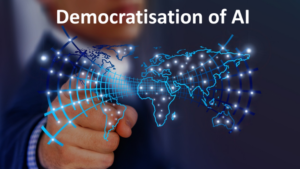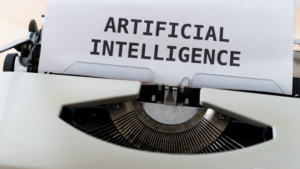The democratization of Artificial Intelligence (AI) refers to making artificial intelligence technologies accessible to a broader audience, beyond just experts and large organizations. This involves simplifying the development, deployment, and use of AI so that more people and smaller entities can leverage its capabilities. Here are the key aspects and impacts of this process.
Key Aspects of Democratization of Artificial Intelligence

1. Accessible Tools and Platforms:
Cloud-based AI Services:
Companies like Google, Amazon, and Microsoft provide cloud-based AI services that offer pre-built models and tools for machine learning, natural language processing, and computer vision. These platforms (e.g., Google Cloud AI, Amazon SageMaker, Microsoft Azure AI) enable users to build and deploy AI applications without deep technical expertise.
Open-Source Frameworks:
Moving on to the practical side, open-source frameworks like TensorFlow, PyTorch, and Keras are valuable tools. These frameworks are open-source and come with extensive documentation and community support. They lower the barrier to entry for individuals and organizations wanting to experiment with AI.
2. Educational Resources:
Online Courses and Tutorials:
Platforms such as Coursera, edX, and Udacity offer courses on AI and machine learning. These resources often include hands-on projects and access to AI tools.
Community Initiatives:
Local AI meetups, hackathons, and online forums (e.g., GitHub, Stack Overflow) provide opportunities for learning and collaboration.
3. Pre-trained Models and APIs:
Model Libraries:
Websites like Hugging Face provide repositories of pre-trained models that can be easily integrated into applications.
APIs for Common Tasks:
Companies offer APIs for tasks such as image recognition, speech-to-text, and language translation, which can be integrated into applications with minimal coding.
4. User-friendly Development Environments:
No-code/Low-code Platforms:
Platforms such as Data Robot, H2O.ai, and Google Auto ML allow users to create AI models using graphical interfaces rather than coding.
Integration with Popular Software:
AI capabilities are increasingly being integrated into widely used software like Excel and CRM systems, making it easier for non-technical users to apply AI.
Impacts of AI Democratization

1.Innovation and Economic Growth:
- Startups and SMEs: With accessible AI tools, startups and small-to-medium enterprises can innovate and compete with larger companies. AI democratization levels the playing field, fostering innovation across industries.
- New Business Models: Easier access to AI enables the creation of new business models and services that were previously not feasible.
2. Workforce Transformation:
- Skill Development: As more people gain access to AI tools, there is a growing demand for AI literacy and skills. This can lead to job creation and upskilling opportunities.
- Job Augmentation: AI can automate repetitive tasks, allowing workers to focus on more complex and creative aspects of their jobs.
3.Social and Ethical Implications:
- Bias and Fairness: As AI becomes more widespread, addressing issues of bias and fairness in AI models is crucial. Diverse teams and perspectives can help create more equitable AI solutions.
- Privacy and Security: In addition, the proliferation of AI applications raises concerns about data privacy and security. Ensuring robust safeguards and ethical practices is essential.
4. Global Reach and Inclusivity:
- Bridging the Digital Divide: Democratizing AI can help bridge the digital divide by providing tools and resources to underserved communities, enabling them to leverage AI for local solutions.
- Solving Global Challenges: AI democratization can contribute to addressing global challenges such as healthcare, education, and environmental sustainability by empowering more people to develop innovative solutions.
Challenges and Considerations
- Quality and Reliability: While the potential of AI is undeniable, ensuring the quality and reliability of models developed by non-experts presents a significant challenge. This is important because there is a risk of misuse or unintended consequences.
- Ethical Use: Furthermore, promoting ethical use of AI and preventing malicious applications is critical as more people gain access to these powerful tools.
- Continuous Learning: AI technologies evolve rapidly, necessitating ongoing education and adaptation for users to stay current.
Conclusion
The democratization of Artificial Intelligence (AI) holds the potential to drive significant advancements and benefits across various sectors, but it must be managed carefully to maximize positive outcomes and minimize risks.

1 thought on “Democratization of Artificial Intelligence: An Overview”